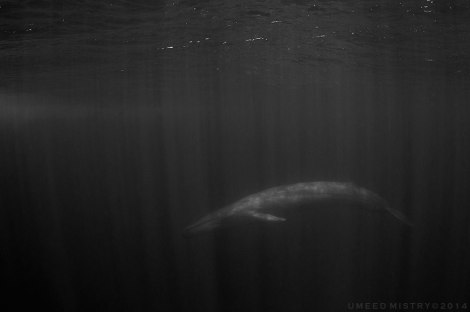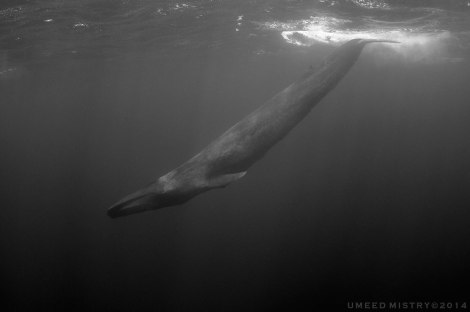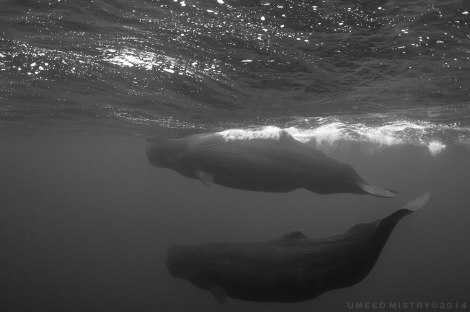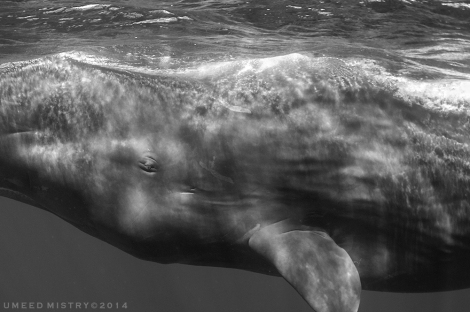2008. A whimsical Skype chat with a friend.
UM: “I wish I had gills.”
BN: “Why?”
UM: “So that I could swim out to the middle of the ocean, dive down to the edge where the blue turns to black, and wait over there.”
BN: “For what”
UM: “For a blue whale to swim past! Can you imagine what that must be like? Tiny Me floating in an endless expanse of water when all of a sudden a giant creature whose heart weighs 6 times more than I do swims past with silent gargantuan grace!!”
BN: “You wouldn’t come to land much would you?”
UM: “No. Probably not.”
BN: “Oh! Have you seen phosphorescence & bio-luminescence in the water?”
UM: “Yes.”
BN: “Do you think human beings have the ability to create phosphorescence?”
UM: “I know that we are not biologically equipped to create our own light, but I think that when we begin to use the capabilities of our beings to their fullest extent we would be able to create our own luminescence.”
BN: “Can you?”
UM: “If I could I would have gills.”
BN: “I think you’ll get there soon.”
UM: “I hope so. There aren’t too many blue whales left.”
…
Six years later.
I went back to Sri Lanka. Once again with ambitious intent. To photograph a blue whale underwater. My attempts the previous year (Sri Lankan Blues-1) had removed all pre-conceived notions about this sort of thing. I didn’t arrive with any grand ideas of having a whale hang out with me, posing for plenty of award-winning images while it fed on a cloud of krill that was miraculously clustered just under the surface instead of hundreds of meters down. Trust me – wildlife photographers secretly entertain these hopeful fantasies. The more seasoned ones perhaps a little less so because their imaginations are tempered by larger doses of reality than the less seasoned ones. But given that good wildlife photography is a combination of preparedness and right-place-right-time chance, there’s never knowing what nature might choose to divulge on any given day. And these fantasies – that one off chance of a once in a lifetime encounter – they’re one of the many things that keep us going.
But this time I had my fins planted firmly in reality. No slow-motion daydreams (complete with background music) of a whale emerging from the depths to check me out, nose to nose, asking about the topside weather and the folks back home. From my experience in Trincomalee , I knew exactly what it was going to take to see this overtly shy giant underwater, much less photograph it.
And when I finally did see our first whale of the trip the rest of the world may as well have stopped. Every aching muscle in my frantically kicking legs, every bit of burning discomfort in my lungs melted into the sea. I was 10 meters below the surface, in 6000 meters of deep blue water, at eye level with a blue whale. Little else makes it into one’s mind in a moment like this – including the need to breathe. She was small, only 12 to 14 meters long (I’m still trying to verify if it was a pygmy blue whale or a sub-adult blue). And she swam past unhurriedly, pausing between thrusts of her tail, taking her time going wherever she was going. I would like to think that she was pausing to look back at me. But that may just be another one of those photographer’s fantasies.

When a blue whale moves, it really moves. And a dwarfed human being, no matter how accomplished a swimmer, is instantly transformed into the slowest of ridiculously slow snails. No amount of kicking until breathless, no amount of breath-held-diving until dizzy, can buy more than a fleeting glimpse of a blue on the move. And so, when this creature, in 6 kilometers worth of deep water waiting to envelop her if she so chooses, does turn around for a second swim-by – it becomes another of the many things that keeps us going.

Blue whales are shy. On the one hand they come up to the surface uncomfortably close to the monstrous cargo ships that dwarf even these largest of living creatures. They seem to have become accustomed to the mechanical giants that ply this route. On the other hand they seem hesitant with us. I wonder if this is true of blue whales everywhere.

There is something to be said for sharing the company of creatures like these in the wild, when they could just as quickly turn away and disappear. There is a sense of connection in knowing that for those fleeting seconds – that seem to slow to long stretches timed only by one’s heartbeat – these animals are okay with this interaction. There is nothing restraining them, nothing keeping them here against their will.

In stark contrast to the shy, solitary blues, our last day at sea brought a pod of about 60 sperm whales making a beeline from west to east. The sperm whales chattered and grunted to each other as they passed. Some dived deep as soon as they saw or sensed us, turning on their sides to look at us from well below the surface. Others swam in for a closer look. One whale swam up to me and began his dive a couple of meters away. Our eyes tracked each other as the distance between us disappeared. I watched him watching me, his large eye turning in its socket, as he dipped his head and broke away from the surface.

Whales are exceptionally intelligent. Some are curious, some are shy. And all of them are communicative, responsive animals that play an active role within their “families”. Research and observation over the last century has taught us much about their migrations, mating and breeding behavior, their use of sonar and the complex languages with which they communicate with each other. We know that an orca from one pod in the North Atlantic would probably not understand an orca from the southern Indian Ocean because they don’t speak the same language. We know that a sperm whale’s ability to map its surroundings through the use of sonar is so highly developed that some scientists claim that they can tell when a human they come in contact with is pregnant or has a tumor. We know that groups of humpbacks in the North Pacific develop hunting strategies that are passed down from the dominant female of the pod to her younger and less-experienced pod members. These are animals that learn, speak and are exceptionally cognizant of their world. We know all this. But for the ocean of information that we have on whales, one can argue that we don’t know very much at all.
Are there whale species that we don’t know exist? Where do blue whales go to birth? What is happening to these animals as a result of climate change and increased pollution of the oceans? How are they evolving? Are the whales around Sri Lanka year-round residents? What are they saying to each other? All these questions and more occupy my mind. I realize that I am in the presence of creatures that live lives shrouded in mystery, helped by the ocean to remain a little beyond our understanding. Arguably, this is probably for the better. And yet, as that last whale turns and dives into the blue nothingness below me, I cannot help but want to follow.
I wish I had gills.

Fabulous Article… and if i had the power, i would grant you gills!
That must have been breathtaking. Beautiful photographs Umeed !
Those whales deserved you…